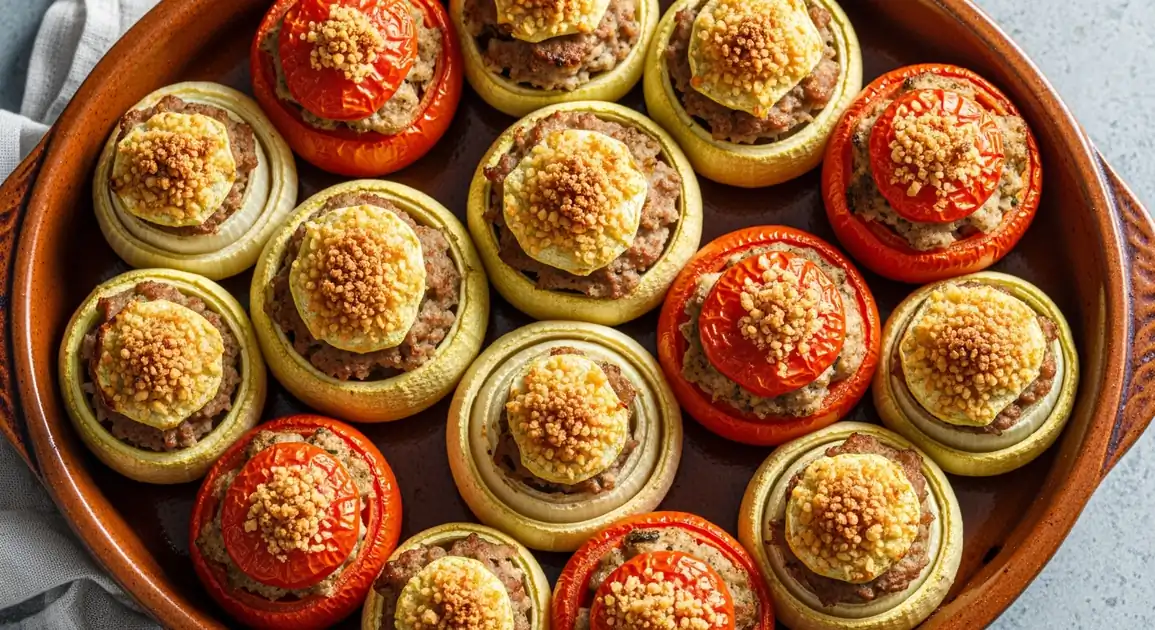Farcis Niçois (Niçoise Stuffed Vegetables)
Farcis Niçois (Les Petits Farcis)

Description
Farcis Niçois are quintessentially from Nice and the Provence region in the South of France. While variations of stuffed vegetables exist elsewhere, the specific Niçoise style using summer vegetables and often a meat/breadcrumb filling is most authentic and prevalent here. They are a common sight in markets, bakeries/caterers ('traiteurs'), and restaurants throughout Provence, especially during summer.
Dietary Information
Serving information
Serving style
Often served lukewarm or at room temperature, especially from takeaways. Sold individually or as an assortment. In restaurants, usually served as a plated starter, sometimes slightly warmed.
Quick facts
Markets: Mornings (e.g., 8 AM - 1 PM). Bakeries/Traiteurs: Usually open through the day (e.g., 8 AM - 7 PM). Restaurants: Lunch (12 PM - 2 PM), Dinner (7 PM onwards).
Safety Tips
What to Look For
-
Purchased from a reputable source (busy market stall, clean traiteur, good restaurant)
Ensures better hygiene standards and likely fresher ingredients.
-
Vegetables and filling look fresh and vibrant
Avoid items that look wilted, dried out, discolored, or have been sitting for a very long time, especially if at room temperature.
-
High turnover at vendor stalls
Especially important for food served at room temperature. Busy stalls mean the food is likely prepared more recently.
-
Served properly hot if ordered in a restaurant setting
If meant to be served hot, it should arrive steaming or very warm.
What to avoid
-
Farcis that look old, dried out, or greasy
Suggests they have been sitting too long or were poorly prepared.
-
Vendors with questionable hygiene practices or unclean displays
Increases the risk of contamination.
-
Buying large quantities late in the day from market stalls
Freshness might be compromised compared to earlier in the day when items are freshly made.
-
Farcis left uncovered and exposed for long periods
Increases risk of contamination from dust, insects, or handling.
Price information
Price range
Budget tips
- Buying per piece from markets or traiteurs is the most budget-friendly way (approx. €2-€4 per piece).
- Restaurants will charge more for a plated starter (e.g., €9-€15 for 3-4 pieces).
- Look for deals when buying multiple pieces from market stalls.
Value indicators
- Generous filling-to-vegetable ratio.
- Fresh appearance and taste.
- Good quality ingredients evident.
- 'Fait Maison' (homemade) often indicates better quality.
Where to Find This Dish
Provence Markets
Found in abundance at daily or weekly markets across Provence, especially larger ones with prepared food sections.
Cours Saleya (Nice), Marché Forville (Cannes), Place Richelme (Aix-en-Provence)
Morning (market hours)
Boulangeries-Pâtisseries with Traiteur Service
Many local bakeries also sell savory prepared items like farcis.
Neighborhood bakeries
Lunchtime
Restaurants with Provençal/Niçoise Cuisine
Standard offering in eateries specializing in local food.
City centers, Old towns
Lunch, Dinner
Vendor Tips
- Specify which vegetables you want or ask for an 'assortiment' (mix).
- Confirm if the filling contains meat ('à la viande') or is vegetarian ('au maigre').
- Best eaten the same day when bought from markets/traiteurs.
How to Order
Regional Variations
-
Farcis au Maigre
(Farcis au Maigre)
A meatless version ('maigre' means 'lean' or 'meatless'). The filling typically uses more vegetables (like Swiss chard - 'blette'), rice, breadcrumbs, herbs, and cheese.
-
Vegetable Selection
(Sélection de Légumes)
While zucchini, tomato, and onion are standard, bell peppers, eggplant, and even large mushrooms can be used depending on availability and preference.
-
Stuffing Variations
(Variations de Farce)
Some recipes might use rice instead of or in addition to breadcrumbs. The type of meat (veal, sausage) and herbs (marjoram, thyme) can also vary.
-
With or Without Cheese
(Avec ou Sans Fromage)
Some fillings include Parmesan or other grated cheese, and it's often sprinkled on top before baking.
Cultural context
History
Rooted in the frugal and resourceful cooking traditions of Provence, 'farcis' were a way to utilize leftover meat and bread along with the abundant summer vegetable harvest. Each family often had its own variation. The dish became a staple in Niçoise homes, markets, and restaurants, celebrating the region's fresh produce and Mediterranean flavors.
Local significance
A beloved staple of Provençal home cooking and market culture. Represents the region's abundant produce and Mediterranean lifestyle.
Eating customs
- Often eaten with hands or a fork, depending on setting.
- Consumed as a starter, light main, or part of a larger spread of Provençal dishes.